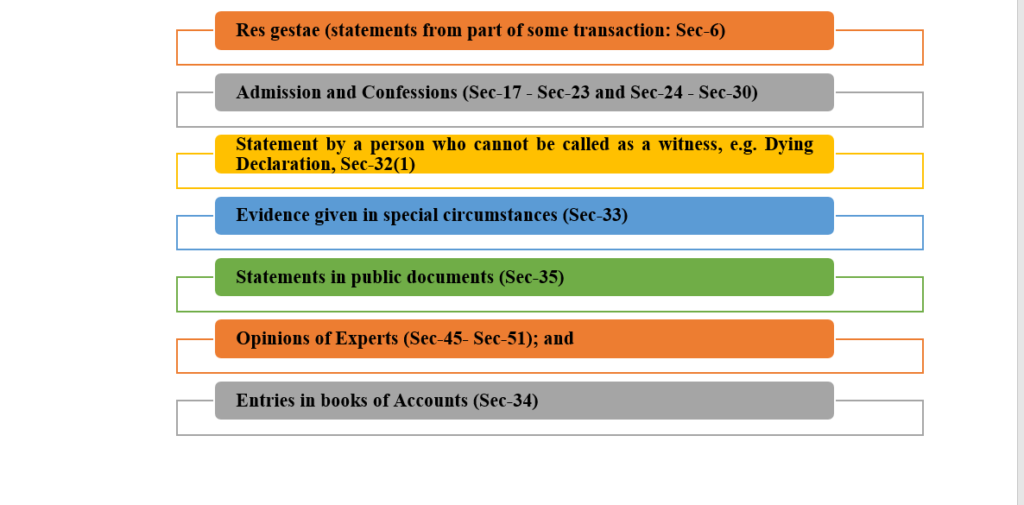INTRODUCTION
Hearsay evidence signifies the evidence heard and said. It is also known as second hand unoriginal evidence because a witness is merely reporting not what he himself saw or heard but what he has learnt in respect of the fact through medium of a 3rd person.
It is a statement made by a witness of what has been said and declared out of Court by a person and not before the Court.
Evidence given by a witness may be oral or documentary.
Under the hearsay rule (Section 60 – Oral evidence must be direct), a court normally refuses to admit as evidence statements that a witness says he or she heard another person say.
Section 60 : Hearsay Rule :
Oral evidence must be direct –
Oral evidence must, in all cases whatever, be direct; that is to say—
- If it refers to a fact which could be seen, it must be the evidence of a witness who says he saw it;
- If it refers to a fact which could be heard, it must be the evidence of a witness who says he heard it;
- If it refers to a fact which could be perceived by any other sense or in any other manner, it must be the evidence of a witness who says he perceived it by that sense or in that manner;
- If it refers to an opinion or to the grounds on which that opinion is held, it must be the evidence of the person who holds that opinion on those grounds.
Provided that the opinions of experts expressed in any treatise commonly offered for sale, and the grounds on which such opinions are held, may be proved by the production of such treatises.
Provided also that, if oral evidence refers to the existence or condition of any material thing other than a document, the Court may, if it thinks fit, require the production of such material thing for its inspection.
Illustration – ‘A’ is being tried for stealing B’s Cycle. ‘C’ as witness says that he (C) heard ’D’ saying that ‘D’ saw ‘A’ with B’s Cycle. Such evidence given by ‘C’ is not admissible on the ground that testimony of C is hearsay evidence.
Why Hearsay Evidence Is Not Admissible
According to the Section 60 of the Indian Evidence Act, 1872 oral evidence to be admissible, it must be direct. In other words, “hearsay evidence is no evidence” is a general rule, because, the hearsay witness may not be able to say correctly and completely the truth of his statement.
Examples of hearsay evidence:
- A statement made by a person, not called as witness;
- A statement contained or recorded in any book, document or record which is not admissible.
Two reasons make hearsay an inadmissible evidence, (i) unfairness, and (ii) possible inaccuracy.
- Unfairness: Allowing a witness to repeat hearsay, is unfair to the accused/ defendant and does not provide him with an opportunity to question the speaker of the original statement.
- Possible Inaccuracy: It is possible that the witness may have misunderstood or misinterpreted the statement. If such evidence is admitted than it will vitiate the proceedings.
For above reasons, counsel of either side can object to admissibility of such a witness’s testimony as hearsay.
Exceptions :
What is not hearsay?
The Indian Evidence Act provides for certain exceptions to the general rule, “hearsay evidence is no evidence”. In other words, hearsay evidence is admissible in the following cases :

Sec-33 : Relevancy of certain evidence for proving, in subsequent proceeding, the truth of facts therein stated :
Section 33 is an exception to the general rule that all evidence must be direct. The theory of evidence is that best evidence must be given.
Therefore where the witness is not available due to reasons mentioned in Section 33 but had given evidence previously in proceedings between same parties, involving same issues and parties had right and opportunity to cross examine him, then Section 33 permits his previous deposition to be given in evidence in subsequent proceedings between same parties. It is based upon the ground of necessity and convenience.
In order to attract the application of section 33, the following conditions must be satisfied:
- The evidence is given by a witness;
- It was given in judicial proceedings or before any person authorized by law to take evidence;
- The witness is unavailable in subsequent proceedings for any reasons stated in S. 33 :-
- when the witness is dead or cannot be found,
- Where the witness is incapable of giving evidence, or
- Where the witness is kept out of the way by the adverse party, or
- If presence of witness cannot be obtained without unreasonable delay or expense
- The proceedings are between the same parties or their representatives in interest;
- The issue or issues involved in both the proceedings must be the same;
- The adverse party in the first proceedings had right and opportunity to cross examine the witness.
Explanation: A criminal trial or enquiry shall be deemed to be a proceeding between the prosecutor and the accused within the meaning of this section.
Evidentiary value:
A previous deposition admitted under section 33 becomes substantive evidence for the purpose of proving truth of facts which it states. It can also be used as an admission against him in his life time. It can be also used Us 145 to contradict him when he deposes regarding same facts.
Case Laws:
Nirmal Singh vs State Of Haryana, AIR 2000 SC 1416, It was held that, Statement of witness recorded under Sec. 299 Cr.P.C. before arrest of absconding accused, can be utilised in trial after arrest only if the witness died or is not available or any other conditions specified in Section 299 Cr.P.C.


